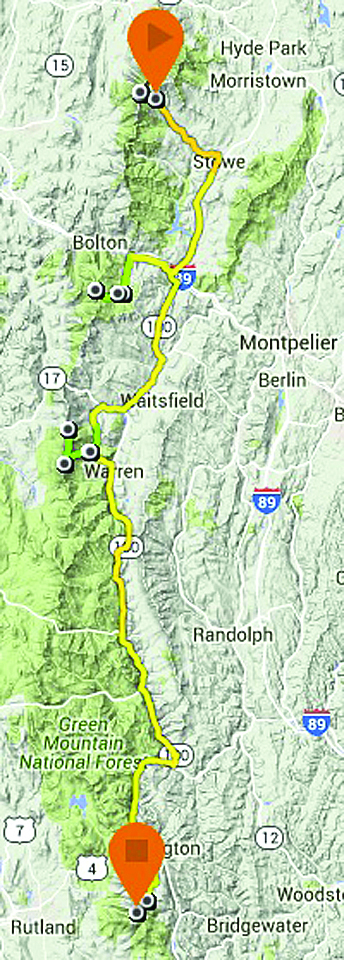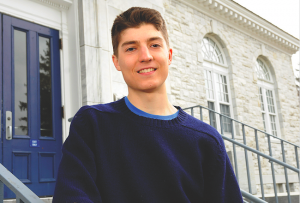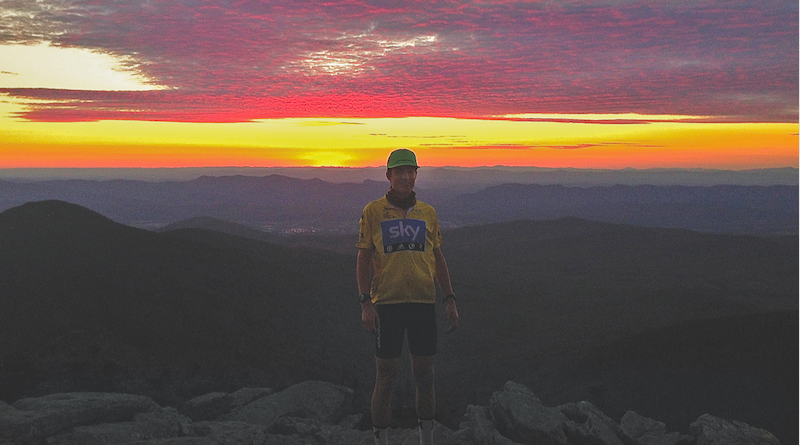Peter Howe’s Peak Performance
By David Fuchs
With the sleet coming down hard on an early spring day, Peter Howe glanced out the window, laced up his running shoes and headed for Middlebury’s Chipman Hill. His stride was light, easy and relaxed as he ascended through the muddy, slushy slop.
On a day when it would be easy stay indoors, the 19-year-old Middlebury College sophomore of Gilmanton Ironworks, N.H., was on his second outdoor run of the afternoon, all part of training for the upcoming ultra-marathon season, and looking to push himself harder than ever before.
Last fall, Howe had already set his own bar bar pretty high. On Oct. 11, 2015, at 2:30 in the morning, Howe has locked his bike to a tree at the base of Mt. Mansfield, Vermont’s tallest mountain. He waved goodbye to his friend Nick Underwood, who had dropped him off, punched “start” on his watch and took off up the mountain with that same easy stride. Precisely 15 hours, 49 minutes, 48 seconds and 126 miles later, he was taking in the sunset from the summit of Killington Mountain — having run up and down Vermont’s five tallest peaks and then biked the 100 miles between them.
 By the numbers, Howe’s day consisted of 26 miles of running and 100 miles of biking with 11,000 feet of elevation gain by foot and 5,000 feet of elevation gain on the bike — a cumulative height taller than any point in the continental United States.
By the numbers, Howe’s day consisted of 26 miles of running and 100 miles of biking with 11,000 feet of elevation gain by foot and 5,000 feet of elevation gain on the bike — a cumulative height taller than any point in the continental United States.
While the numbers alone are impressive, they weren’t Howe’s only motivation.
“I was out there to have fun. The goal was not to do it as fast as I could; it was just to go out there for the adventure of it,” Howe said. And what an adventure he had.
Running by headlamp, Howe made a quick 47-minute ascent to the summit of Mt. Mansfield, skimming along the Long Trail south from his starting point on Route 108.
The night was cool and clear and the stars were phenomenal, Howe said. It was his first time on top of the 4,393-foot peak, so he paused a beat at the summit to take in the night views of Burlington, Stowe and Waterbury. With the rest of the day ahead of him, though, he knew he couldn’t linger and made an easy descent to the base.
At the parking lot, he threw on his bike kit, took a swig of water, scarfed down a banana and was ready to roll. He switched on the headlamp duct-taped to his helmet, passed his friend who was still asleep in his car and eased into the 25-mile stretch on Route 100 to Camel’s Hump in Duxbury.
For Howe, who’s much more at home on his feet than in the saddle, it was a long time to be on the bike. So, when he pulled up to the trailhead an hour and 45 minutes later, he was already itching to run.
Changing back into his running gear at the base of mountain, Howe sensed he had an opportunity to make it to the 4,083-foot summit before sunrise — an idea that was so exciting that he ran up faster than was sensible, he later admitted.
In this case, however, the risk was worth the reward. Not only did he make it to the top of the mountain by sunrise but he also ran into two friends who had mentioned that they might hike up the night before. Seeing Howe, they reached into their stash of zucchini bread and handed him a few much-appreciated slices.
“Seeing people out there was something to really look forward to throughout this adventure,” Howe said. “Even knowing there was a chance of seeing them up top made it really exciting for me to get up there,” he said.
After 10 minutes of snacking, chatting and taking in the sunrise, the wind took its toll. Howe started to cool down and took it as a cue to get moving again. On the descent, he let himself loose.“I was just flowing with the trail, which felt really good,” he said.
Two hours and 26 miles of biking later, Howe was at the base of Sugarbush’s Organ Grinder trail, looking up the 2,400 feet of vertical rise to the top of Lincoln Peak. It was 10 a.m. and he was halfway through the day, feeling good but starting to slow down.
In particular, he said, he noticed his sluggishness in the transition times between the bike and the trail. “I was really trying to hold myself to 10 minutes but the minutes just went by so fast in terms of the time it took to change my shoes, find a tree, lock my bike, grab some food, drink some water, send a text and all that stuff. It all just started to take longer,” he said.
Nonetheless, Howe set out, climbing to the top of Lincoln Peak (elevation 3,975 feet) and running the three-mile ridge traverse to the summit of Mt. Ellen (4,083 feet) in an hour and 18 minutes. With the third mountain of the day under his belt, Howe was excited to run back along the ridge to the top of the 4,006-foot Mt. Abraham in Lincoln where he said he knew his friend Nick Underwood would be waiting.
When they met at the peak, Underwood said Howe looked surprisingly normal. “He looked like he was just out for a run, light on his feet, just bouncing up the hill,” Underwood said. Underwood handed him a banana and a donut and unsuccessfully tried to take a picture before his phone died in the cold. For Howe, who was clad in nothing but a T-shirt and shorts, a few minutes were all he could spare, Underwood said.
“He looked like his energy level and his stoke were still high but even hanging with him for five minutes, I could tell he was antsy to keep moving forward,” he said. “When you know you have that much left in front of you, it’s hard to hit pause.” “At that point, I was in a good place mentally and a good place physically. Everything had gone as well as it possibly could have,” Howe said. Howe’s spirits kept up during the descent to his bike back in Warren.
“It was a gorgeous day, blue-bird skies and the fall foliage was fully ablaze, and I knew if I could get to that point feeling good, then I could do the whole thing,” Howe said.
However, the hard times were still to come.
“I got on my bike and it was a straight shot on 100 south to Killington. The first bit was enjoyable and then it slowly turned into a grind,” he said. “My body was not used to being on the bike for that long.”
 Being in a relatively fixed position while biking started to cause him intense pain in his shoulders and back, Howe said. “That was the point in the day when I went from having a ton of fun on this adventure to just saying ‘Let’s just finish what I started.’”
Being in a relatively fixed position while biking started to cause him intense pain in his shoulders and back, Howe said. “That was the point in the day when I went from having a ton of fun on this adventure to just saying ‘Let’s just finish what I started.’”
So, he pushed through the pain, across the land and over the last 50 miles to the town of Killington. In the final stretch, six miles from the base, Howe got a flat tire. This moment — stranded on the side of the road, struggling to inflate his new tube with a small hand-pump and only two hours of sleep the night before — is where he really felt the accumulation of the day, Howe said. In a stroke of luck, a local bike storeowner who was driving by stopped his truck, pulled out a full-size pump and inflated his tube for him.
Despite that moment of good chance, Howe wasn’t out of the woods just yet. Cycling the last six miles to the base of the mountain involved 1,000 feet of elevation gain. “Without being over-dramatic about it, that climb took everything I had,” he said. “It’s a pretty steep access road. There were some sections where I was pedaling as hard as I could and was scared I would fall off my bike because I was moving so slowly.”
When he arrived at the parking lot, said Scott Berkley, a close friend and running partner was waiting to complete the last leg of the odyssey with Howe. “He was glaring, covered in grease from fixing his flat tire and taking a while to respond to my questions and cheers so I knew he was in the pain cave,” Berkley said.
However, once Howe had eaten, changed and was back on the trail, Berkley said he knew there was no need for concern. “We started going up at a rate of 1,200 feet per mile … and Peter was crushing it,” he said. “I was struggling to keep up with him.”
Forty-one minutes after they started, Howe and Berkley were standing atop the 4,235-foot summit, just in time for one of the most beautiful sunsets of his life, Howe said.
When asked about the inspiration for the route, Howe points to Jeff Colt, Forrest Carrol and Christian Johansen, three Middlebury College students who skinned and skied the same five mountains in one day during the previous winter.
However, Howe made it clear that this journey was not about bragging rights or athletic one-upmanship.
While he acknowledged that running Vermont’s five 4,000-foot peaks and biking the 100 miles in between carried an aesthetic appeal, his inspiration for the adventure ties back to the land itself.
“For me, running on a trail is the most physical, real way of connecting with a landscape and connecting with the world around me,” he said. “I don’t consider myself an athlete,” he said. “I’ve come to think of my running and my experience running more as an art than as a sport.”
Although his views on running have evolved with time, Howe does come from a competitive running background. He ran cross-country and track throughout high school and competed in cross-country during his freshman year at Middlebury. Even in high school, his aptitude for running in the mountains was remarkable, earning him one of four spots on the junior division of the U.S. Men’s Mountain Running Team.
Howe first entered the realm of extreme endurance events when he was 15 years old, hiking the 52-mile Appalachian Mountain Club’s high hut traverse in the White Mountains with his older sister in slightly more than 28 hours. Since then, he’s completed the same route a number of times. On his latest attempt — which took place just two weeks prior to his big run in the Green Mountains — he finished the route in 12 hours and 49 minutes, the second-fastest recorded time according to fastestknowntimes.com.
Outside of the White Mountains, Howe has completed a number of long-distance mountain routes, including a traverse though the High Peaks Range in the Adirondacks in early February of this year. Howe completed the 25-mile run in just less than seven hours, a time he attributes to this season’s unusually mild conditions.
Howe has a number of plans in the works for the upcoming season, including a route through the Sandwich Range in New Hampshire and completing his home state’s section of the Appalachian Trail. In both cases, Howe will have plenty of time to plan and train while working for the Randolph Mountain Club as a hut caretaker in the White Mountains this summer.
In the meantime, Howe is looking forward to spending the rest of the spring training and adventuring with friends in Vermont. Taking a step back from all these accomplishments, Howe doesn’t see himself as remarkable:
“It was just me putting one foot in front of the other — doing something extraordinary through the very ordinary process of putting one foot in front the other.”
David Fuchs is a junior at Middlebury College and an intern for The Addison Independent, where this story first appeared.

